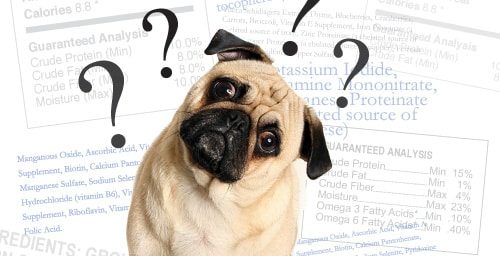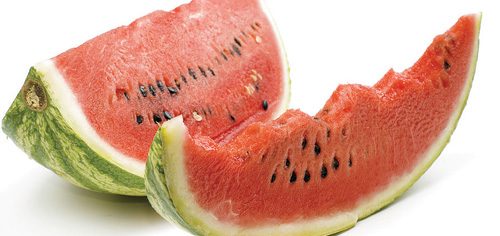

Feeding Fido
How to really read a dog food label
Do you worry about the quality of your beloved
dog’s diet, but glaze over when you try to decipher
the nutritional information on the packages? What
do those multisyllabic words and confusing numbers actually
mean?
Understanding dog food labels and using that information
wisely can make the difference between choosing a good
quality dog food or settling for a dud.
How to Really Read Dog Food Labels
Dog food packaging usually includes three sets of information:
the front panel, the guaranteed analysis, and the list of
ingredients. Each of these gives you important information
to help you make an informed decision.
The first place to start is the front of the package. You
want to select a food or treat that is suited to your dog. The
front panel gives you information on the brand, the main
ingredients, the life stage the food is made for, and if there
are any breed-specific goals for the food (e.g., it is specifically
intended for giant breeds or for Miniature Dachshunds).
A typical guaranteed analysis provides information about
crude protein, crude fat, crude fibre, and moisture. You will
sometimes see guarantees for other nutrients such as vitamins
and minerals, omega fatty acids, or glucosamine. Knowing
these other nutrient guarantees
can help you compare foods
or find a food that meets your
dog’s specific needs.
The guaranteed analysis,
however, does not address the
quality or digestibility of the
ingredients. To get a sense of
the quality of the food, you
need to look at the list of
ingredients.
In the United States the
Association of American Feed
Control Officials (AAFCO)
establishes standards on which
individual states base their
regulations. Canadian pet
foods are usually packaged
and labelled in accordance
with AAFCO guidelines and
Canadian federal regulations
such as the Consumer
Packaging and Labelling Act
and the Health of Animals
Regulations. Under AAFCO,
ingredients are listed in order
based on weight, so items at the top of the list are the main
ingredients.
A good-quality dog food will have meat listed within the
first three ingredients. However, since ingredients are listed
in order based on weight, having fresh chicken as your
#1 ingredient does not necessarily mean that the product
contains a lot of chicken, as fresh chicken contains a lot
of water, which bumps up the weight of that ingredient.
On the other hand, if chicken meal is the first ingredient
listed, you know that there is far more chicken in the food,
because meal is light in weight. In order for light-weight
chicken meal to be the #1 ingredient by weight, the food
must contain a large quantity of it.
Another way that ingredient lists can be deceptive is
through the practice of “splitting.” If an ingredient list read
“Rice, meat, etc.” you would know immediately that there is
more rice than meat in the food. However, if the rice content
is split into several ingredients, the company can legitimately
list meat as the top ingredient, thus: “Meat, ground rice, rice
flour, rice bran, etc.” When added together, these grains
may actually be present at levels that are higher than the
meat.
Other items to note when reading the ingredient list: food
dyes, flavourings, and preservatives.
Dog Food Dilemma:
What to Choose
Now that we understand the
type of information to be found
on a food label, let’s discuss
how to use that information
wisely to choose a good-quality
dog food.
When comparing dog
foods, you should consider the
amount of moisture present
in each food. The guaranteed
analysis is listed on an “as-fed”
basis (AFB) which is a term
used in nutrition to indicate the
percentage of moisture in the
food has not been factored into
the calculation of percentages
of crude protein, crude fat, and
crude fibre. If two foods have
different moisture guarantees,
you need to correct the values
to a “dry-matter” basis (DMB).
To do this you’ll need a calculator
and some simple math.
Let’s look at the guaranteed analysis of
two sample foods given on an as-fed basis:
| Food A (Dry kibble) |
Food B (Canned) |
|
|---|---|---|
| Crude Protein | 26% | 8% |
| Crude Fat | 16% | 3.4% |
| Crude Fibre | 3% | 1% |
| Moisture | 12% | 82% |
Based on this, you might think the dry
food contains a greater percentage of all the
listed nutrients. However, if we correct the
values to DMB, a different picture emerges.
To do the calculation:
- Locate the percentage of the nutrient
(e.g., protein).
For Food A, this would be 26%. - Determine the percentage of dry matter
by subtracting the moisture percentage
from 100
(100% – moisture content = dry matter)
For food A, this would be 100% – 12% =
88% dry matter - Divide the percentage of the nutrient
by the percentage of dry matter and multiply
by 100.
For Food A, this would be 26% ÷ 88%
x 100) = 29% protein
The number that you get should be higher
than the number reported on the label
because you’ve removed the moisture.
Now compare the two foods again, this
time on a DMB:
| Food A (Dry kibble) |
Food B (Canned) |
|
|---|---|---|
| Crude Protein | 29% | 44% |
| Crude Fat | 18% | 18.5% |
| Crude Fibre | 3.4% | 3.5% |
| Moisture | 0% | 0% |
At first glance, the dry food appeared
to have higher guarantees, but when you
correct for the moisture and convert to a
DMB, the canned food is actually higher in
protein.
Remember that higher levels of nutrients
aren’t always better; there is an optimal
percentage depending on your dog’s
requirements and lifestage. Most dog foods are formulated to slightly exceed your
dog’s nutrient requirements. When
choosing an adult dog food, pick a food
that has between 18-28 percent protein
as listed on the label, unless your dog
has other specific requirements, as discussed
with your vet.
Both canned and dry dog foods are
designed to provide a complete and balanced
diet for your dog. One 421mL can
(13 oz) of dog food has approximately
the same caloric content as 1 cup of
kibble. Canned dog food must contain
about 80 percent water to allow for
proper canning, so you will often find
water or broth as the second or third
ingredient on a can of food. The process
of canning preserves the food, so there is
no need to have preservatives in canned
dog food. However, the high moisture
content in canned food also means you
are feeding (and paying for) a lot of
water.
When choosing canned dog food, look
for one that has a whole meat listed as
its first ingredient (e.g. fresh beef). In a
dry food, a meat meal (species should
be identified, e.g., chicken meal) should
be one of the top ingredients, to ensure
adequate protein levels.
Stay away from “mystery” meat (e.g.,
unidentified-species meat and meal). An
ingredient list should always state the
species of meat (e.g., chicken, turkey,
trout, etc.). If it doesn’t, it is using a
mixed source of meat, which can be
of questionable origin. Plus, the mixed
source will not be consistent from batch
to batch and this may upset your dog’s
stomach.
There is no scientific evidence to suggest
that consumption of food dye is
harmful to your dog. However, your dog
does not need or even enjoy food dye.
The colouring is there to make the product
more marketable to you—the dog
owner. Choose foods that do not have a
lot of dye in them.
Dog foods, like people foods, will
spoil over time. To prevent this, preservatives
are added to kibble to allow
for a longer shelf life. BHA, BHT, and
ethoxyquin are synthetic preservatives
and vitamin E (tocopherol), and vitamin
C (ascorbic acid) are natural preservatives. Multiple studies have shown that consumption of preservatives
such as BHA, BHT, and ethoxyquin are not associated with
cancer. In fact, some studies have indicated that they may, in fact,
be protective against cancer. However, there has been concern that
some dogs may develop allergies to synthetic preservatives. If you
are concerned about your dog consuming synthetic preservatives,
choose foods that have been preserved with vitamin E or C.
Fresh vegetables are sometimes added to dog foods to help
dogs that have grain sensitivities. If you are looking for a food that
contains veggies, look for veggies to be listed high on the list of
ingredients. Veggies are around 80 percent water, so if they are at
the bottom of the ingredient list, you are just paying for expensive
water.
Some food manufacturers are starting to include a range of nontraditional
ingredients such as fruits and plant extracts and herbal
supplements. In most cases, these have not been proven to be
useful to dogs, and often there is little data to support the safety of
feeding these ingredients. While we may know that blueberries are
full of antioxidants and are good for people to eat, there is nothing
to show that there is any benefit to including these in a dry dog
food. In addition, it’s important to remember that not everything
that is safe for people is also safe for dogs. For the vast majority
of herbal supplements, we have no idea what they do in a dog’s
body, and there may be a synergistic action between herbal supplements
during the cooking process that may be harmful to dogs or
interact with medications that your dog may be on.
If you are choosing to feed a commercial dog food, one of the
best ways to improve your dog’s health and well-being is to feed
an appropriate amount of a good-quality dog food. With a good
diet, your dog will live a longer, healthier life. When examining
dog food labels, take your time to do the research needed. If you
have questions, the best people to ask are the companies themselves,
your vet, or a qualified canine nutritionist.
Join the newsletter and never miss out on dog content again!
"*" indicates required fields
By clicking the arrow, you agree to our web Terms of Use and Privacy & Cookie Policy. Easy unsubscribe links are provided in every email.





